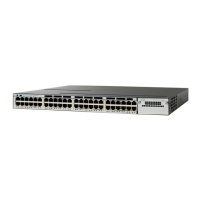2-271
Catalyst 3750 Metro Switch Command Reference
OL-9645-10
Chapter 2 Catalyst 3750 Metro Switch Cisco IOS Commands
match (class-map configuration)
Note Though visible in the command-line help strings, the any, class-map, destination-address, not,
protocol, and source-address keywords are not supported.
Defaults No match criteria are defined.
Command Modes Class-map configuration
Command History
Usage Guidelines Before entering the match command, you must first enter the class-map global configuration command
to specify the name of the class whose match criteria you want to establish. The match command is used
to specify which fields in the packets are examined to classify the packets. If a packet matches the
specified criteria, the packet is considered a member of the class and is forwarded according to the
quality of service (QoS) specifications set in the traffic policy.
For the match ip dscp dscp-list or the match ip precedence ip-precedence-list command, you can enter
a mnemonic name for a commonly used value. For example, you can enter the match ip dscp af11
command, which is the same as entering the match ip dscp 10 command. You can enter the match ip
precedence critical command, which is the same as entering the match ip precedence 5 command. For
a list of supported mnemonics, enter the match ip dscp ? or the match ip precedence ? command to
see the command-line help strings.
You can configure the match cos [inner] cos-list, match ip dscp dscp-list, match ip precedence
ip-precedence-list, match mpls experimental exp-list, or the match vlan command in a class map
within a policy map attached to an enhanced-services (ES) port. The match access-group
acl-index-or-name command is not supported in an egress policy attached to an ES port or in a
hierarchical ingress policy attached to an ES port. You can configure only the match access-group
acl-index-or-name command and the match input-interface interface-id-list command in a single-level
ingress policy map attached to a standard port or to an ES port.
The match cos inner cos-list command has no effect on non-802.1Q tunneling traffic.
If you want to match the CoS of traffic received on an ES port that is in 802.1Q tunneling mode, use the
match cos cos-list command rather than the match cos inner cos-list command. The traffic is not tagged
twice at the time that the match takes place.
You cannot mix VLAN-level and class-level matches within a class map.
To configure a class map that matches an 802.1Q tunneling pair (instead of matching a single VLAN),
you must configure the class-map global configuration command with the match-all keyword. You must
enter the match vlan command before the match vlan inner command.
If you enter the match vlan or the match vlan inner command, the class-map match-any command is
not supported.
Use the input-interface interface-id-list keyword when you are configuring an interface-level class map
in a hierarchical dual-level policy map. For the interface-id-list, you can specify up to six entries.
Release Modification
12.1(14)AX This command was introduced.
12.2(25)EY The inner and the input-interface keywords were added.

